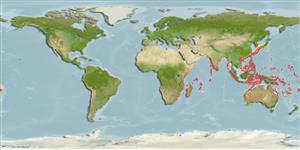分類 / Names
俗名 | 同種異名 | Catalog of Fishes(屬, 種) | ITIS | CoL | WoRMS | Cloffa
Teleostei >
Pleuronectiformes (Flatfishes)
鰈形目 (Flatfishes) >
Bothidae (Lefteye flounders)
鮃科 (Lefteye flounders)
Etymology: Taeniopsetta: Latin, taenia = stripe + Greek, psetta = grouper (Ref. 45335).
More on author: Günther.
Environment: milieu / climate zone / depth range / distribution range
生態學
海洋 居於水底的; 深度上下限 150 - 278 m (Ref. 44037). 深水域
Indo-West Pacific: including Japan.
印度-西太平洋: 包括日本。
大小 / 重量 / 年齡
Maturity: Lm ? range ? - ? cm
Max length : 11.4 cm SL 雄魚/尚未辨別雌雄; (Ref. 11148)
簡短描述
型態特徵 | 形態測量圖
背棘 (總數): 0; 背的軟條 (總數): 85-97; 臀棘 0; 臀鰭軟條: 71 - 81; 脊椎骨: 40 - 42. Pelvic fin on ocular side slightly elongate, extending to near the tip of the isthmus, the distance between the tip of the isthmus and the insertion of the pelvic fine subequal to the length of the pelvic fin base. Second ray of the pelvic fin on ocular side opposite to the 1st on the blind side. In male, the 12th to 18th dorsal rays and the 1st to 8th anal rays greatly elongated into filaments (Ref. 559). Soft ray count of pectoral fin refers to that on ocular side.
在有眼睛的一邊上的腹鰭些微地延長,延伸到峽部的頂端附近, 那峽部的頂端與腹鰭的嵌入細的幾乎等於腹鰭基底的長度之間的距離。 在有眼睛的一邊上的腹鰭的第二個鰭條在沒有眼睛的一邊上位於第一對面。 在雄魚, 這第 12 到第 18個背鰭鰭條與第 8個臀鰭鰭條的第一中非常延長變成絲狀突起。 (參考文獻 559) 胸鰭的軟鰭條計數以有眼睛的一邊為準。
Life cycle and mating behavior
成熟度 | 繁殖 | 產卵場 | 卵 | 孕卵數 | 仔魚
印度-西太平洋: 包括日本。
Masuda, H., K. Amaoka, C. Araga, T. Uyeno and T. Yoshino, 1984. The fishes of the Japanese Archipelago. Vol. 1. Tokai University Press, Tokyo, Japan. 437 p. (text). (Ref. 559)
人類使用
更多資訊
俗名同種異名新陳代謝捕食者生態毒物學繁殖成熟度產卵場產卵群集孕卵數卵卵發育
年龄/大小成長長度-重量長度-長度長度-頻率形態測量圖型態特徵仔魚稚魚動力學入添量豐度BRUVS
參考文獻養殖養殖資訊品種遺傳學Electrophoreses遺傳率疾病加工NutrientsMass conversion
工具
特別的報告
下載 XML
網路資源
Estimates based on models
Preferred temperature (Ref.
123201): 13.8 - 21.4, mean 16.9 °C (based on 86 cells).
Phylogenetic diversity index (Ref.
82804): PD
50 = 0.7500 [Uniqueness, from 0.5 = low to 2.0 = high].
Bayesian length-weight: a=0.00912 (0.00408 - 0.02036), b=3.05 (2.87 - 3.23), in cm total length, based on LWR estimates for this (Sub)family-body shape (Ref.
93245).
營養階層 (Ref.
69278): 3.5 ±0.4 se; based on size and trophs of closest relatives
回復力 (Ref.
120179): 中等的, 族群倍增時間最少 1.4 - 4.4年 (Preliminary K or Fecundity.).
Fishing Vulnerability (Ref.
59153): Low vulnerability (10 of 100).
